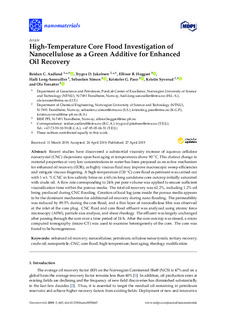| dc.contributor.author | Aadland, Reidun Cecilie Grønfur | |
| dc.contributor.author | Jakobsen, Trygve Dagsloth | |
| dc.contributor.author | Heggset, Ellinor Bævre | |
| dc.contributor.author | Long-Sanouiller, Haili | |
| dc.contributor.author | Simon, Sebastien Charles | |
| dc.contributor.author | Paso, Kristofer Gunnar | |
| dc.contributor.author | Syverud, Kristin | |
| dc.contributor.author | Torsæter, Ole | |
| dc.date.accessioned | 2019-09-27T08:42:27Z | |
| dc.date.available | 2019-09-27T08:42:27Z | |
| dc.date.created | 2019-07-16T12:52:35Z | |
| dc.date.issued | 2019 | |
| dc.identifier.citation | Nanomaterials. 2019, 9 (665), 1-25. | nb_NO |
| dc.identifier.issn | 2079-4991 | |
| dc.identifier.uri | http://hdl.handle.net/11250/2619081 | |
| dc.description.abstract | Recent studies have discovered a substantial viscosity increase of aqueous cellulose nanocrystal (CNC) dispersions upon heat aging at temperatures above 90 °C. This distinct change in material properties at very low concentrations in water has been proposed as an active mechanism for enhanced oil recovery (EOR), as highly viscous fluid may improve macroscopic sweep efficiencies and mitigate viscous fingering. A high-temperature (120 °C) core flood experiment was carried out with 1 wt. % CNC in low salinity brine on a 60 cm-long sandstone core outcrop initially saturated with crude oil. A flow rate corresponding to 24 h per pore volume was applied to ensure sufficient viscosification time within the porous media. The total oil recovery was 62.2%, including 1.2% oil being produced during CNC flooding. Creation of local log-jams inside the porous media appears to be the dominant mechanism for additional oil recovery during nano flooding. The permeability was reduced by 89.5% during the core flood, and a thin layer of nanocellulose film was observed at the inlet of the core plug. CNC fluid and core flood effluent was analyzed using atomic force microscopy (AFM), particle size analysis, and shear rheology. The effluent was largely unchanged after passing through the core over a time period of 24 h. After the core outcrop was rinsed, a micro computed tomography (micro-CT) was used to examine heterogeneity of the core. The core was found to be homogeneous. | nb_NO |
| dc.language.iso | eng | nb_NO |
| dc.publisher | MDPI | nb_NO |
| dc.rights | Navngivelse 4.0 Internasjonal | * |
| dc.rights.uri | http://creativecommons.org/licenses/by/4.0/deed.no | * |
| dc.title | High-Temperature Core Flood Investigation of Nanocellulose as a Green Additive for Enhanced Oil Recovery | nb_NO |
| dc.type | Journal article | nb_NO |
| dc.type | Peer reviewed | nb_NO |
| dc.description.version | publishedVersion | nb_NO |
| dc.source.pagenumber | 1-25 | nb_NO |
| dc.source.volume | 9 | nb_NO |
| dc.source.journal | Nanomaterials | nb_NO |
| dc.source.issue | 665 | nb_NO |
| dc.identifier.doi | 10.3390/nano9050665 | |
| dc.identifier.cristin | 1711655 | |
| dc.relation.project | Norges forskningsråd: 262644 | nb_NO |
| dc.description.localcode | © 2019 by the authors. Licensee MDPI, Basel, Switzerland. This article is an open access article distributed under the terms and conditions of the Creative Commons Attribution (CC BY) license (http://creativecommons.org/licenses/by/4.0/). | nb_NO |
| cristin.unitcode | 194,64,90,0 | |
| cristin.unitcode | 194,66,30,0 | |
| cristin.unitname | Institutt for geovitenskap og petroleum | |
| cristin.unitname | Institutt for kjemisk prosessteknologi | |
| cristin.ispublished | true | |
| cristin.fulltext | original | |
| cristin.qualitycode | 1 | |

